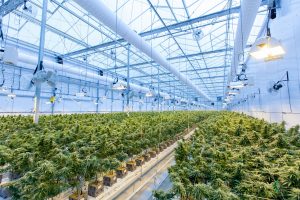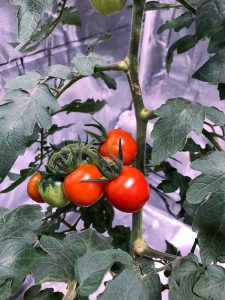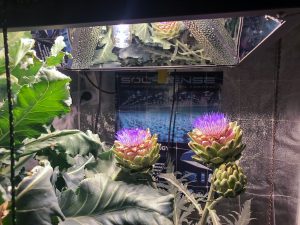To accelerate the backcrossing process used to incorporate new rust-resistance genes into commercial wheat cultivars, we have been trialling new light-emitting diode (LED) lamps with the aim of developing controlled growth facilities that are energy efficient and produce multiple generations of high-quality plants a year.
LED technology is finding increasing applications in plant growth; however, fine-tuning the light spectrum for cereal growth has taken significant trial and error, and development in collaboration with an LED supply company (Grow Candy).
The lights now being used at the Plant Breeding Institute (PBI) mean that cereal plants can be grown from seed to harvest in 12 weeks. Compared with previous plant-growth room designs, the newly designed rooms use much less energy because the LED lamps emit very little heat.
The plants grown under LED lights maintain the same growth form they would develop in the paddock under conditions ideal for cross-pollinating, enabling important rust-resistance germplasm to be fast-tracked to Australian growers.
More than 40 per cent of the wheat cultivars currently grown in Australia carry rust-resistance genes from donor germplasm generated at PBI.
New sources of rust resistance are identified through lengthy testing in the greenhouse and field, followed by detailed genetic analyses.
In the past five years, 24 new rust-resistance genes have been found and characterised in wheat and barley at PBI. These resistant genes include: Yr51, Yr55, Yr56, Yr57, Yr58, Yr63, Yr66, Yr67, Yr70, Yr71, Yr72, Yr73, Yr74, and Yr75 for wheat stripe rust; Lr65, Lr71, Lr73, Lr74, and Lr76 for wheat leaf rust; Sr48, Sr49 and Sr56 for wheat stem rust; and Rph21 and Rph23 for barley leaf rust.
Most of these genes were found in low-quality germplasm. As a result, many had to be crossed with locally adapted germplasm before they could be used in commercial breeding.
This backcrossing typically involves seven generations of crossing to ensure the desired rust-resistance is retained, while the low-yielding, poor-quality attributes are left behind.
At the end of this backcrossing process, final selections are made and distributed to breeders for use in developing high-yielding, high-quality, rust-resistant cultivars.
More information:
GroundCover™ Issue: 123
Professor Robert Park,
02 9351 8806,
[email protected]
@rpark_f (Twitter)
Dr Will Cuddy, 02 9351 8771,
[email protected]




